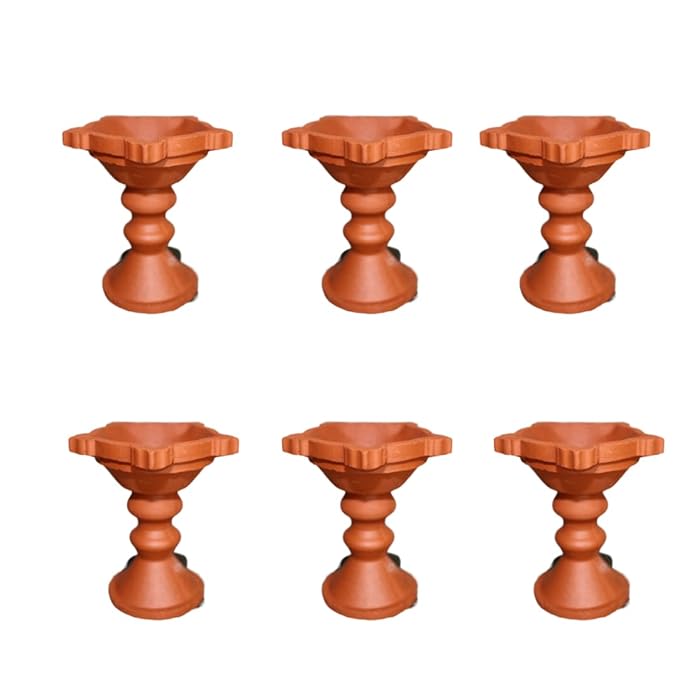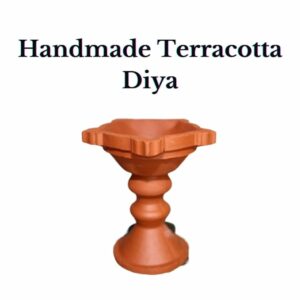Clay diyas, a long-standing tradition, have graced festive occasions and spiritual ceremonies with their warm, inviting glow for centuries. They are more than mere objects of utility; they are symbols of a rich and vibrant culture.

It represents enlightenment, prosperity, knowledge and wisdom. Diyas are manufactured by rural potters.
1. Rediscovering the Elegance of Clay Diyas with Stands
Clay diyas have long been a symbol of tradition and spiritual purity in Indian culture. However, when paired with a stand, these humble lamps transform into a testament of elegance and functionality. The clay diya with stand is not just a source of light; it’s a beacon of cultural heritage.
“Tradition is not to preserve the ashes, but to pass on the flame.” – Gustav Mahler
2. Design and Functionality: The Stand Makes a Difference
Clay diyas with stands are uniquely designed for stability and aesthetic appeal. The stands, often artistically crafted, ensure the diyas are secure, reducing the risk of spills. These designs range from simple, rustic styles to elaborate, ornate patterns, catering to diverse tastes and decor themes.
2.1 The Craftsmanship
The creation of clay diyas involves a delicate balance of skill, patience, and creativity. Each diya is unique, bearing the mark of the artisan’s craft.
2.2 The Design
From simple, unadorned diyas to ones intricately designed and adorned with colors and glitters – the variety is endless.
- Simple diyas
- Decorative diyas
- Painted diyas
3. Artisanal Craftsmanship: The Heart of Clay Diyas
Each clay diya with stand is a product of meticulous craftsmanship. Artisans shape, design, and fire these lamps, embedding a piece of tradition in every curve. The variety is astounding, from plain, unadorned diyas to intricately designed masterpieces, each telling a story of cultural richness.
4. Cultural and Symbolic Significance: Lighting Up Traditions
In Indian culture, light symbolizes knowledge and purity. Clay diyas with stands illuminate homes during festivals like Diwali, Karthikai Deepam, and Navaratri, representing the triumph of light over darkness and wisdom over ignorance.
| Festival | Significance of Diya |
|---|---|
| Diwali | Victory of light over darkness |
| Karthikai Deepam | Light of Lord Shiva |
| Navaratri | Worship of Goddess Durga |
5. The Eco-Friendly Choice: Sustainability in Tradition
Opting for clay diyas with stands is a step towards sustainability. Made from natural materials, these diyas are biodegradable and environmentally friendly, aligning with the growing global emphasis on eco-conscious living.
6. Practical Guide: Usage and Maintenance
Using clay diyas with stands is simple yet graceful. Fill them with oil, place a cotton wick, and light it up. Their design ensures easy cleaning and maintenance, making them a practical choice for any occasion.
7. Where to Find: A Guide to Purchasing
These traditional lamps are available at local markets, craft fairs, and online platforms. From Amazon to artisanal websites, there’s a range of options catering to various preferences and budgets.

8. DIY Clay Diyas: Crafting Personalized Tradition
Making your own clay diyas with stands is not just a creative endeavor, but also a way to connect with a rich cultural tradition. This hands-on activity can be a fun project for families, especially during festive times. Here’s a detailed guide to help you create your own clay diyas with stands:
Materials Needed:
- Natural clay
- Rolling pin or flat surface
- Small bowl or diya mold
- Carving tools or small knife
- Sandpaper (optional)
- Non-toxic paints and brushes
- Glitter, beads, or other decorative items
- Varnish or sealant (optional)
Step-by-Step Guide:
- Prepare the Clay:
- Start by kneading the clay until it’s pliable. If it’s too dry, add a little water; if too wet, add more clay. Achieving the right consistency is crucial for molding.
- Shape the Diya:
- Roll out the clay on a flat surface. For the base, cut out a circle of about 3-4 inches in diameter. For the stand, form a smaller circle and gently curve the edges upward.
- Press the smaller circle (the stand) onto the center of the larger circle (the base). Smooth out the edges where they meet to ensure stability.
- Mold the Bowl:
- Use a small bowl or a diya mold to shape the upper part of the diya. Place the clay over the mold and gently press to form the shape. Carefully remove it and smooth any rough edges.
- Add Details:
- Use carving tools or a small knife to etch designs or patterns onto the diya and stand. This is where you can get creative with traditional or contemporary designs.
- Dry the Diya:
- Allow the diya to dry naturally. Avoid direct sunlight as it can cause the clay to crack. Drying time may vary depending on the thickness of the clay and the humidity.
- Sand and Paint:
- Once dry, use sandpaper to smooth any rough surfaces. Paint the diya with non-toxic paints, choosing colors that reflect your style. Add decorative elements like glitter or beads for a festive look.
- Seal the Diya:
- Optionally, apply a varnish or sealant to protect the paint and add a glossy finish. Ensure the sealant is non-toxic and heat resistant.
- Curing the Diya:
- For added durability, you may cure the diya in an oven following specific clay curing instructions. This step is optional but can add longevity to your creation.
Tips and Tricks:
- Experiment with different sizes and shapes to create a unique set.
- Involve children in the decorating process for a fun family activity.
- Use these handmade diyas as gifts to share a piece of tradition with friends and family.
Safety Note:
Always place diyas on a heat-resistant surface and never leave them unattended when lit.
9. Gifting and Future Trends
Clay diyas with stands are gaining popularity as thoughtful, eco-friendly gifts. Their demand is rising, not just in India but globally, as people seek sustainable and culturally rich decor options.
10. Conclusion
Clay diyas with stands embody the essence of tradition, blending aesthetic appeal with practicality. They remind us of the beauty in simplicity and the joy of celebrating with environmental consciousness.
“Traditions touch us, they connect us and they expand us.” – Rita Wilson
Clay diyas with stand – a tradition worth cherishing, a memory worth creating.

